How Social Media Influences Restaurant Choices: London Sector Analysis
VerifiedAdded on 2020/11/12
|49
|14819
|418
Report
AI Summary
This report investigates the influence of social media marketing strategies on consumer purchasing decision-making within the London restaurant sector. The study explores the impact of social media platforms, such as Facebook and Instagram, on consumer choices, focusing on how online reviews, user-generated content, and marketing strategies affect the customer decision-making process. The research examines the rationale behind the topic, the research problems, questions, aims, and objectives, along with the significance of the study. The literature review covers social media marketing, consumer behavior, and customer decision-making models. The methodology section details the research design, data collection methods, reliability, and ethical considerations. The report aims to identify effective social media marketing strategies for restaurants in London, determine the factors influencing consumer purchasing decisions, and investigate how these strategies affect the decision-making process. The analysis also considers the shift from mass media marketing to social media and its implications for the restaurant industry.
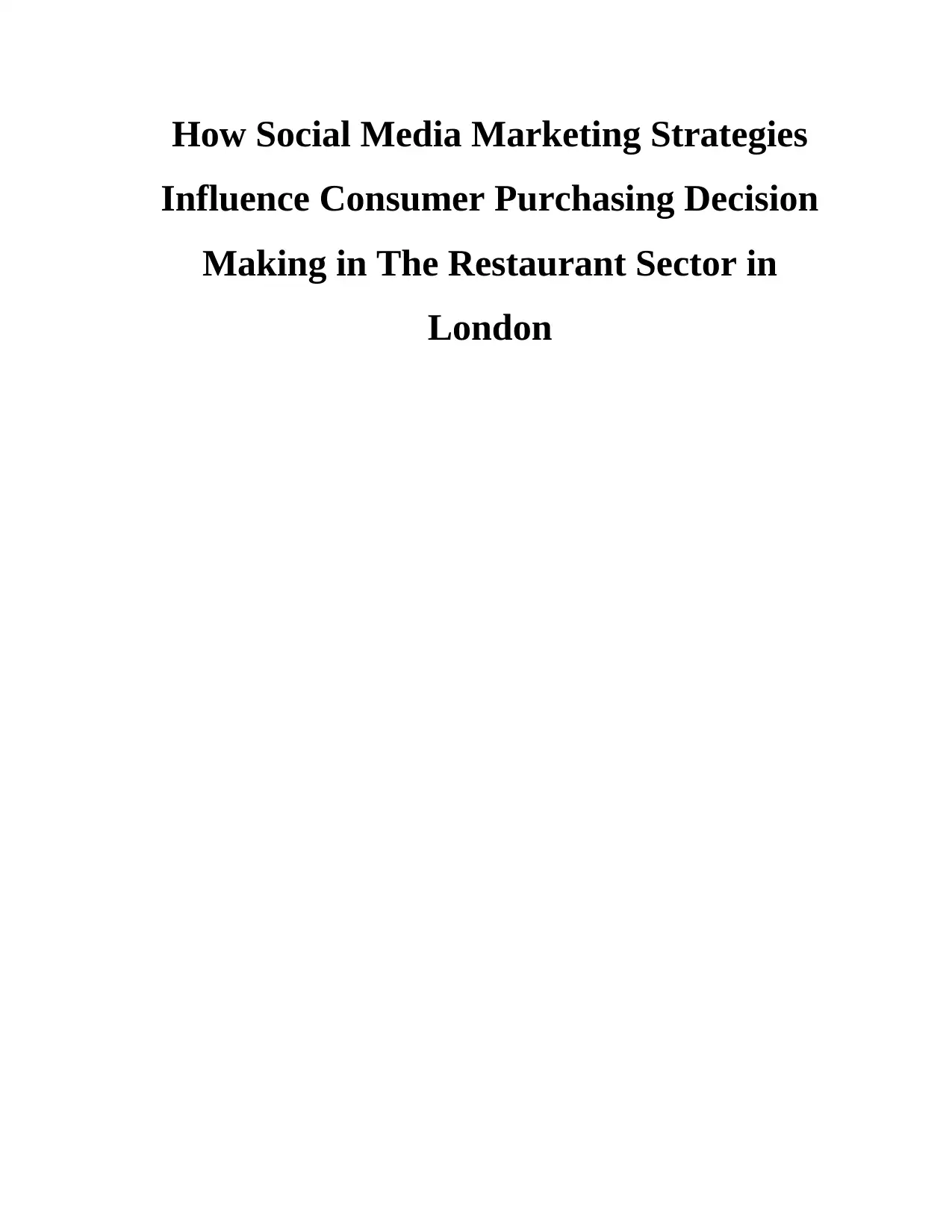
How Social Media Marketing Strategies
Influence Consumer Purchasing Decision
Making in The Restaurant Sector in
London
Influence Consumer Purchasing Decision
Making in The Restaurant Sector in
London
Paraphrase This Document
Need a fresh take? Get an instant paraphrase of this document with our AI Paraphraser
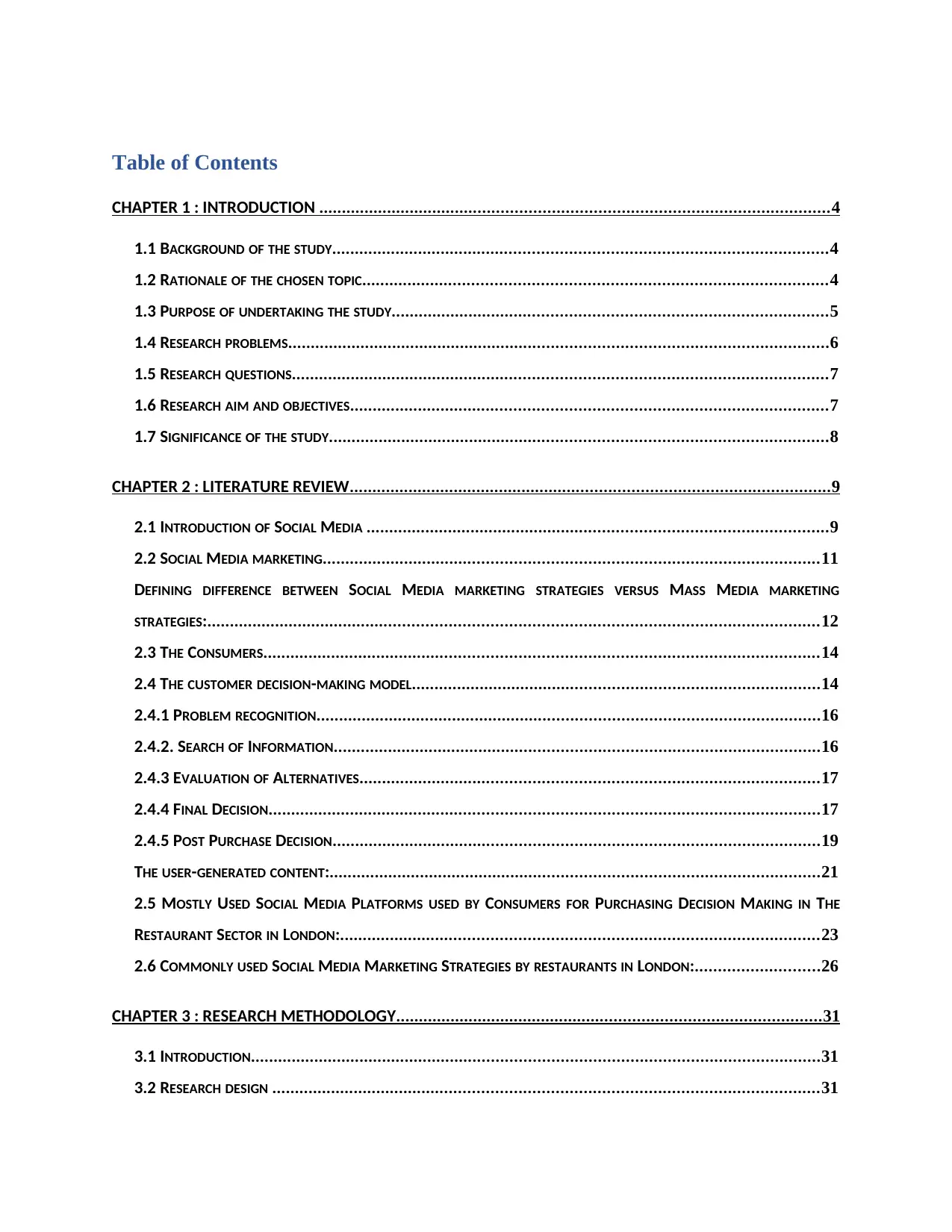
Table of Contents
CHAPTER 1 : INTRODUCTION ...............................................................................................................4
1.1 BACKGROUND OF THE STUDY............................................................................................................4
1.2 RATIONALE OF THE CHOSEN TOPIC.....................................................................................................4
1.3 PURPOSE OF UNDERTAKING THE STUDY...............................................................................................5
1.4 RESEARCH PROBLEMS......................................................................................................................6
1.5 RESEARCH QUESTIONS.....................................................................................................................7
1.6 RESEARCH AIM AND OBJECTIVES........................................................................................................7
1.7 SIGNIFICANCE OF THE STUDY.............................................................................................................8
CHAPTER 2 : LITERATURE REVIEW.........................................................................................................9
2.1 INTRODUCTION OF SOCIAL MEDIA .....................................................................................................9
2.2 SOCIAL MEDIA MARKETING............................................................................................................11
DEFINING DIFFERENCE BETWEEN SOCIAL MEDIA MARKETING STRATEGIES VERSUS MASS MEDIA MARKETING
STRATEGIES:.....................................................................................................................................12
2.3 THE CONSUMERS.........................................................................................................................14
2.4 THE CUSTOMER DECISION-MAKING MODEL.........................................................................................14
2.4.1 PROBLEM RECOGNITION..............................................................................................................16
2.4.2. SEARCH OF INFORMATION..........................................................................................................16
2.4.3 EVALUATION OF ALTERNATIVES....................................................................................................17
2.4.4 FINAL DECISION........................................................................................................................17
2.4.5 POST PURCHASE DECISION..........................................................................................................19
THE USER-GENERATED CONTENT:...........................................................................................................21
2.5 MOSTLY USED SOCIAL MEDIA PLATFORMS USED BY CONSUMERS FOR PURCHASING DECISION MAKING IN THE
RESTAURANT SECTOR IN LONDON:........................................................................................................23
2.6 COMMONLY USED SOCIAL MEDIA MARKETING STRATEGIES BY RESTAURANTS IN LONDON:...........................26
CHAPTER 3 : RESEARCH METHODOLOGY.............................................................................................31
3.1 INTRODUCTION............................................................................................................................31
3.2 RESEARCH DESIGN .......................................................................................................................31
CHAPTER 1 : INTRODUCTION ...............................................................................................................4
1.1 BACKGROUND OF THE STUDY............................................................................................................4
1.2 RATIONALE OF THE CHOSEN TOPIC.....................................................................................................4
1.3 PURPOSE OF UNDERTAKING THE STUDY...............................................................................................5
1.4 RESEARCH PROBLEMS......................................................................................................................6
1.5 RESEARCH QUESTIONS.....................................................................................................................7
1.6 RESEARCH AIM AND OBJECTIVES........................................................................................................7
1.7 SIGNIFICANCE OF THE STUDY.............................................................................................................8
CHAPTER 2 : LITERATURE REVIEW.........................................................................................................9
2.1 INTRODUCTION OF SOCIAL MEDIA .....................................................................................................9
2.2 SOCIAL MEDIA MARKETING............................................................................................................11
DEFINING DIFFERENCE BETWEEN SOCIAL MEDIA MARKETING STRATEGIES VERSUS MASS MEDIA MARKETING
STRATEGIES:.....................................................................................................................................12
2.3 THE CONSUMERS.........................................................................................................................14
2.4 THE CUSTOMER DECISION-MAKING MODEL.........................................................................................14
2.4.1 PROBLEM RECOGNITION..............................................................................................................16
2.4.2. SEARCH OF INFORMATION..........................................................................................................16
2.4.3 EVALUATION OF ALTERNATIVES....................................................................................................17
2.4.4 FINAL DECISION........................................................................................................................17
2.4.5 POST PURCHASE DECISION..........................................................................................................19
THE USER-GENERATED CONTENT:...........................................................................................................21
2.5 MOSTLY USED SOCIAL MEDIA PLATFORMS USED BY CONSUMERS FOR PURCHASING DECISION MAKING IN THE
RESTAURANT SECTOR IN LONDON:........................................................................................................23
2.6 COMMONLY USED SOCIAL MEDIA MARKETING STRATEGIES BY RESTAURANTS IN LONDON:...........................26
CHAPTER 3 : RESEARCH METHODOLOGY.............................................................................................31
3.1 INTRODUCTION............................................................................................................................31
3.2 RESEARCH DESIGN .......................................................................................................................31
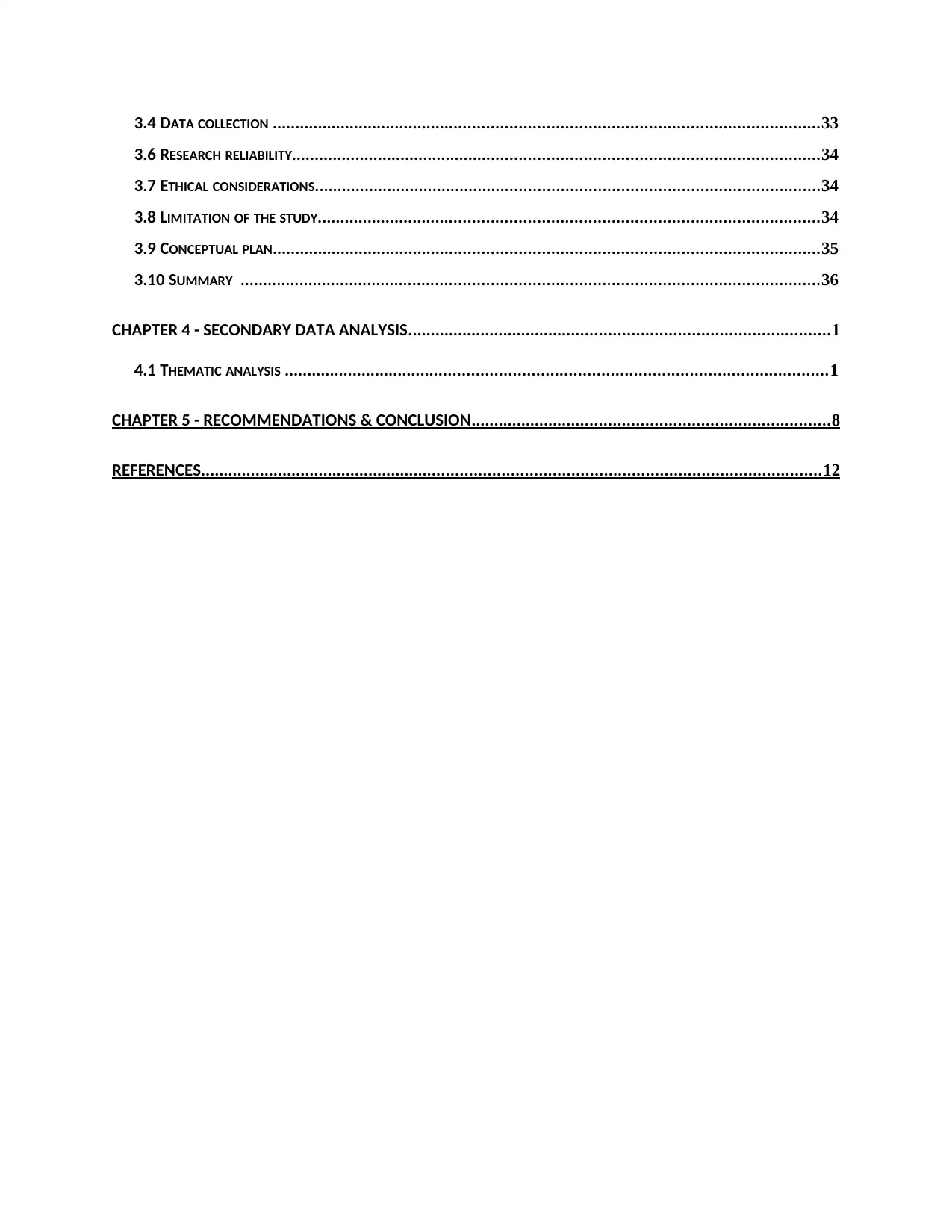
3.4 DATA COLLECTION .......................................................................................................................33
3.6 RESEARCH RELIABILITY...................................................................................................................34
3.7 ETHICAL CONSIDERATIONS..............................................................................................................34
3.8 LIMITATION OF THE STUDY.............................................................................................................34
3.9 CONCEPTUAL PLAN.......................................................................................................................35
3.10 SUMMARY ..............................................................................................................................36
CHAPTER 4 - SECONDARY DATA ANALYSIS............................................................................................1
4.1 THEMATIC ANALYSIS ......................................................................................................................1
CHAPTER 5 - RECOMMENDATIONS & CONCLUSION..............................................................................8
REFERENCES.......................................................................................................................................12
3.6 RESEARCH RELIABILITY...................................................................................................................34
3.7 ETHICAL CONSIDERATIONS..............................................................................................................34
3.8 LIMITATION OF THE STUDY.............................................................................................................34
3.9 CONCEPTUAL PLAN.......................................................................................................................35
3.10 SUMMARY ..............................................................................................................................36
CHAPTER 4 - SECONDARY DATA ANALYSIS............................................................................................1
4.1 THEMATIC ANALYSIS ......................................................................................................................1
CHAPTER 5 - RECOMMENDATIONS & CONCLUSION..............................................................................8
REFERENCES.......................................................................................................................................12
⊘ This is a preview!⊘
Do you want full access?
Subscribe today to unlock all pages.

Trusted by 1+ million students worldwide
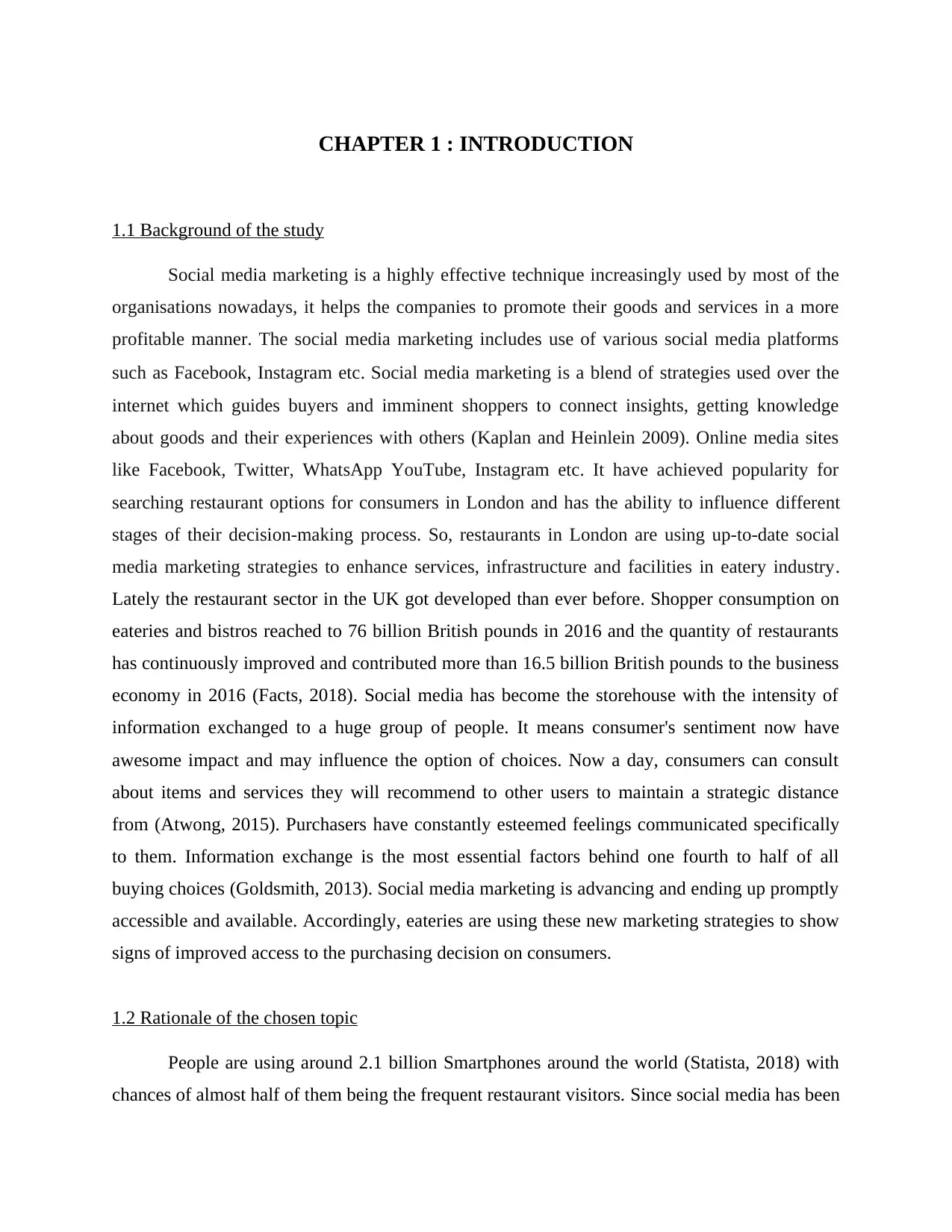
CHAPTER 1 : INTRODUCTION
1.1 Background of the study
Social media marketing is a highly effective technique increasingly used by most of the
organisations nowadays, it helps the companies to promote their goods and services in a more
profitable manner. The social media marketing includes use of various social media platforms
such as Facebook, Instagram etc. Social media marketing is a blend of strategies used over the
internet which guides buyers and imminent shoppers to connect insights, getting knowledge
about goods and their experiences with others (Kaplan and Heinlein 2009). Online media sites
like Facebook, Twitter, WhatsApp YouTube, Instagram etc. It have achieved popularity for
searching restaurant options for consumers in London and has the ability to influence different
stages of their decision-making process. So, restaurants in London are using up-to-date social
media marketing strategies to enhance services, infrastructure and facilities in eatery industry.
Lately the restaurant sector in the UK got developed than ever before. Shopper consumption on
eateries and bistros reached to 76 billion British pounds in 2016 and the quantity of restaurants
has continuously improved and contributed more than 16.5 billion British pounds to the business
economy in 2016 (Facts, 2018). Social media has become the storehouse with the intensity of
information exchanged to a huge group of people. It means consumer's sentiment now have
awesome impact and may influence the option of choices. Now a day, consumers can consult
about items and services they will recommend to other users to maintain a strategic distance
from (Atwong, 2015). Purchasers have constantly esteemed feelings communicated specifically
to them. Information exchange is the most essential factors behind one fourth to half of all
buying choices (Goldsmith, 2013). Social media marketing is advancing and ending up promptly
accessible and available. Accordingly, eateries are using these new marketing strategies to show
signs of improved access to the purchasing decision on consumers.
1.2 Rationale of the chosen topic
People are using around 2.1 billion Smartphones around the world (Statista, 2018) with
chances of almost half of them being the frequent restaurant visitors. Since social media has been
1.1 Background of the study
Social media marketing is a highly effective technique increasingly used by most of the
organisations nowadays, it helps the companies to promote their goods and services in a more
profitable manner. The social media marketing includes use of various social media platforms
such as Facebook, Instagram etc. Social media marketing is a blend of strategies used over the
internet which guides buyers and imminent shoppers to connect insights, getting knowledge
about goods and their experiences with others (Kaplan and Heinlein 2009). Online media sites
like Facebook, Twitter, WhatsApp YouTube, Instagram etc. It have achieved popularity for
searching restaurant options for consumers in London and has the ability to influence different
stages of their decision-making process. So, restaurants in London are using up-to-date social
media marketing strategies to enhance services, infrastructure and facilities in eatery industry.
Lately the restaurant sector in the UK got developed than ever before. Shopper consumption on
eateries and bistros reached to 76 billion British pounds in 2016 and the quantity of restaurants
has continuously improved and contributed more than 16.5 billion British pounds to the business
economy in 2016 (Facts, 2018). Social media has become the storehouse with the intensity of
information exchanged to a huge group of people. It means consumer's sentiment now have
awesome impact and may influence the option of choices. Now a day, consumers can consult
about items and services they will recommend to other users to maintain a strategic distance
from (Atwong, 2015). Purchasers have constantly esteemed feelings communicated specifically
to them. Information exchange is the most essential factors behind one fourth to half of all
buying choices (Goldsmith, 2013). Social media marketing is advancing and ending up promptly
accessible and available. Accordingly, eateries are using these new marketing strategies to show
signs of improved access to the purchasing decision on consumers.
1.2 Rationale of the chosen topic
People are using around 2.1 billion Smartphones around the world (Statista, 2018) with
chances of almost half of them being the frequent restaurant visitors. Since social media has been
Paraphrase This Document
Need a fresh take? Get an instant paraphrase of this document with our AI Paraphraser
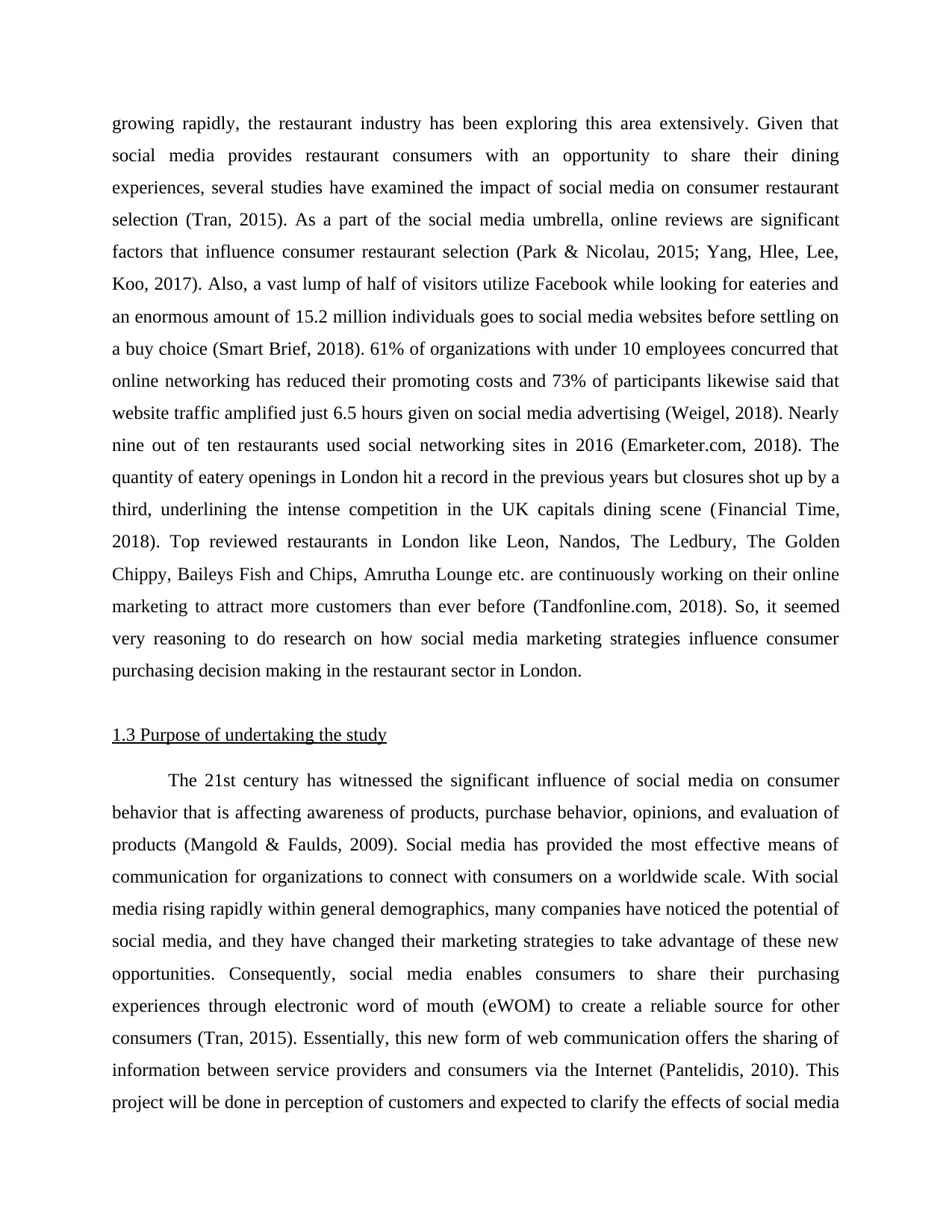
growing rapidly, the restaurant industry has been exploring this area extensively. Given that
social media provides restaurant consumers with an opportunity to share their dining
experiences, several studies have examined the impact of social media on consumer restaurant
selection (Tran, 2015). As a part of the social media umbrella, online reviews are significant
factors that influence consumer restaurant selection (Park & Nicolau, 2015; Yang, Hlee, Lee,
Koo, 2017). Also, a vast lump of half of visitors utilize Facebook while looking for eateries and
an enormous amount of 15.2 million individuals goes to social media websites before settling on
a buy choice (Smart Brief, 2018). 61% of organizations with under 10 employees concurred that
online networking has reduced their promoting costs and 73% of participants likewise said that
website traffic amplified just 6.5 hours given on social media advertising (Weigel, 2018). Nearly
nine out of ten restaurants used social networking sites in 2016 (Emarketer.com, 2018). The
quantity of eatery openings in London hit a record in the previous years but closures shot up by a
third, underlining the intense competition in the UK capitals dining scene ( Financial Time,
2018). Top reviewed restaurants in London like Leon, Nandos, The Ledbury, The Golden
Chippy, Baileys Fish and Chips, Amrutha Lounge etc. are continuously working on their online
marketing to attract more customers than ever before (Tandfonline.com, 2018). So, it seemed
very reasoning to do research on how social media marketing strategies influence consumer
purchasing decision making in the restaurant sector in London.
1.3 Purpose of undertaking the study
The 21st century has witnessed the significant influence of social media on consumer
behavior that is affecting awareness of products, purchase behavior, opinions, and evaluation of
products (Mangold & Faulds, 2009). Social media has provided the most effective means of
communication for organizations to connect with consumers on a worldwide scale. With social
media rising rapidly within general demographics, many companies have noticed the potential of
social media, and they have changed their marketing strategies to take advantage of these new
opportunities. Consequently, social media enables consumers to share their purchasing
experiences through electronic word of mouth (eWOM) to create a reliable source for other
consumers (Tran, 2015). Essentially, this new form of web communication offers the sharing of
information between service providers and consumers via the Internet (Pantelidis, 2010). This
project will be done in perception of customers and expected to clarify the effects of social media
social media provides restaurant consumers with an opportunity to share their dining
experiences, several studies have examined the impact of social media on consumer restaurant
selection (Tran, 2015). As a part of the social media umbrella, online reviews are significant
factors that influence consumer restaurant selection (Park & Nicolau, 2015; Yang, Hlee, Lee,
Koo, 2017). Also, a vast lump of half of visitors utilize Facebook while looking for eateries and
an enormous amount of 15.2 million individuals goes to social media websites before settling on
a buy choice (Smart Brief, 2018). 61% of organizations with under 10 employees concurred that
online networking has reduced their promoting costs and 73% of participants likewise said that
website traffic amplified just 6.5 hours given on social media advertising (Weigel, 2018). Nearly
nine out of ten restaurants used social networking sites in 2016 (Emarketer.com, 2018). The
quantity of eatery openings in London hit a record in the previous years but closures shot up by a
third, underlining the intense competition in the UK capitals dining scene ( Financial Time,
2018). Top reviewed restaurants in London like Leon, Nandos, The Ledbury, The Golden
Chippy, Baileys Fish and Chips, Amrutha Lounge etc. are continuously working on their online
marketing to attract more customers than ever before (Tandfonline.com, 2018). So, it seemed
very reasoning to do research on how social media marketing strategies influence consumer
purchasing decision making in the restaurant sector in London.
1.3 Purpose of undertaking the study
The 21st century has witnessed the significant influence of social media on consumer
behavior that is affecting awareness of products, purchase behavior, opinions, and evaluation of
products (Mangold & Faulds, 2009). Social media has provided the most effective means of
communication for organizations to connect with consumers on a worldwide scale. With social
media rising rapidly within general demographics, many companies have noticed the potential of
social media, and they have changed their marketing strategies to take advantage of these new
opportunities. Consequently, social media enables consumers to share their purchasing
experiences through electronic word of mouth (eWOM) to create a reliable source for other
consumers (Tran, 2015). Essentially, this new form of web communication offers the sharing of
information between service providers and consumers via the Internet (Pantelidis, 2010). This
project will be done in perception of customers and expected to clarify the effects of social media
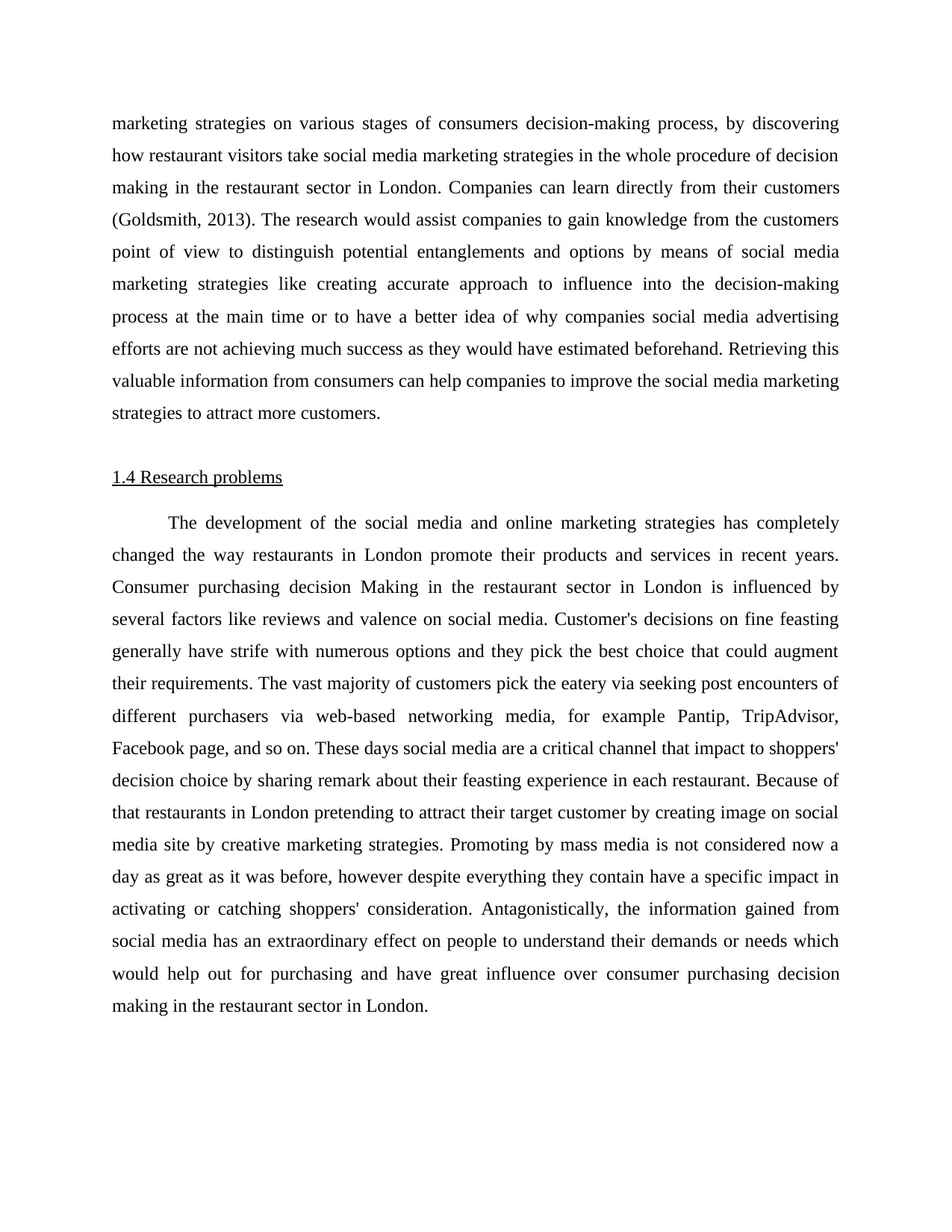
marketing strategies on various stages of consumers decision-making process, by discovering
how restaurant visitors take social media marketing strategies in the whole procedure of decision
making in the restaurant sector in London. Companies can learn directly from their customers
(Goldsmith, 2013). The research would assist companies to gain knowledge from the customers
point of view to distinguish potential entanglements and options by means of social media
marketing strategies like creating accurate approach to influence into the decision-making
process at the main time or to have a better idea of why companies social media advertising
efforts are not achieving much success as they would have estimated beforehand. Retrieving this
valuable information from consumers can help companies to improve the social media marketing
strategies to attract more customers.
1.4 Research problems
The development of the social media and online marketing strategies has completely
changed the way restaurants in London promote their products and services in recent years.
Consumer purchasing decision Making in the restaurant sector in London is influenced by
several factors like reviews and valence on social media. Customer's decisions on fine feasting
generally have strife with numerous options and they pick the best choice that could augment
their requirements. The vast majority of customers pick the eatery via seeking post encounters of
different purchasers via web-based networking media, for example Pantip, TripAdvisor,
Facebook page, and so on. These days social media are a critical channel that impact to shoppers'
decision choice by sharing remark about their feasting experience in each restaurant. Because of
that restaurants in London pretending to attract their target customer by creating image on social
media site by creative marketing strategies. Promoting by mass media is not considered now a
day as great as it was before, however despite everything they contain have a specific impact in
activating or catching shoppers' consideration. Antagonistically, the information gained from
social media has an extraordinary effect on people to understand their demands or needs which
would help out for purchasing and have great influence over consumer purchasing decision
making in the restaurant sector in London.
how restaurant visitors take social media marketing strategies in the whole procedure of decision
making in the restaurant sector in London. Companies can learn directly from their customers
(Goldsmith, 2013). The research would assist companies to gain knowledge from the customers
point of view to distinguish potential entanglements and options by means of social media
marketing strategies like creating accurate approach to influence into the decision-making
process at the main time or to have a better idea of why companies social media advertising
efforts are not achieving much success as they would have estimated beforehand. Retrieving this
valuable information from consumers can help companies to improve the social media marketing
strategies to attract more customers.
1.4 Research problems
The development of the social media and online marketing strategies has completely
changed the way restaurants in London promote their products and services in recent years.
Consumer purchasing decision Making in the restaurant sector in London is influenced by
several factors like reviews and valence on social media. Customer's decisions on fine feasting
generally have strife with numerous options and they pick the best choice that could augment
their requirements. The vast majority of customers pick the eatery via seeking post encounters of
different purchasers via web-based networking media, for example Pantip, TripAdvisor,
Facebook page, and so on. These days social media are a critical channel that impact to shoppers'
decision choice by sharing remark about their feasting experience in each restaurant. Because of
that restaurants in London pretending to attract their target customer by creating image on social
media site by creative marketing strategies. Promoting by mass media is not considered now a
day as great as it was before, however despite everything they contain have a specific impact in
activating or catching shoppers' consideration. Antagonistically, the information gained from
social media has an extraordinary effect on people to understand their demands or needs which
would help out for purchasing and have great influence over consumer purchasing decision
making in the restaurant sector in London.
⊘ This is a preview!⊘
Do you want full access?
Subscribe today to unlock all pages.

Trusted by 1+ million students worldwide
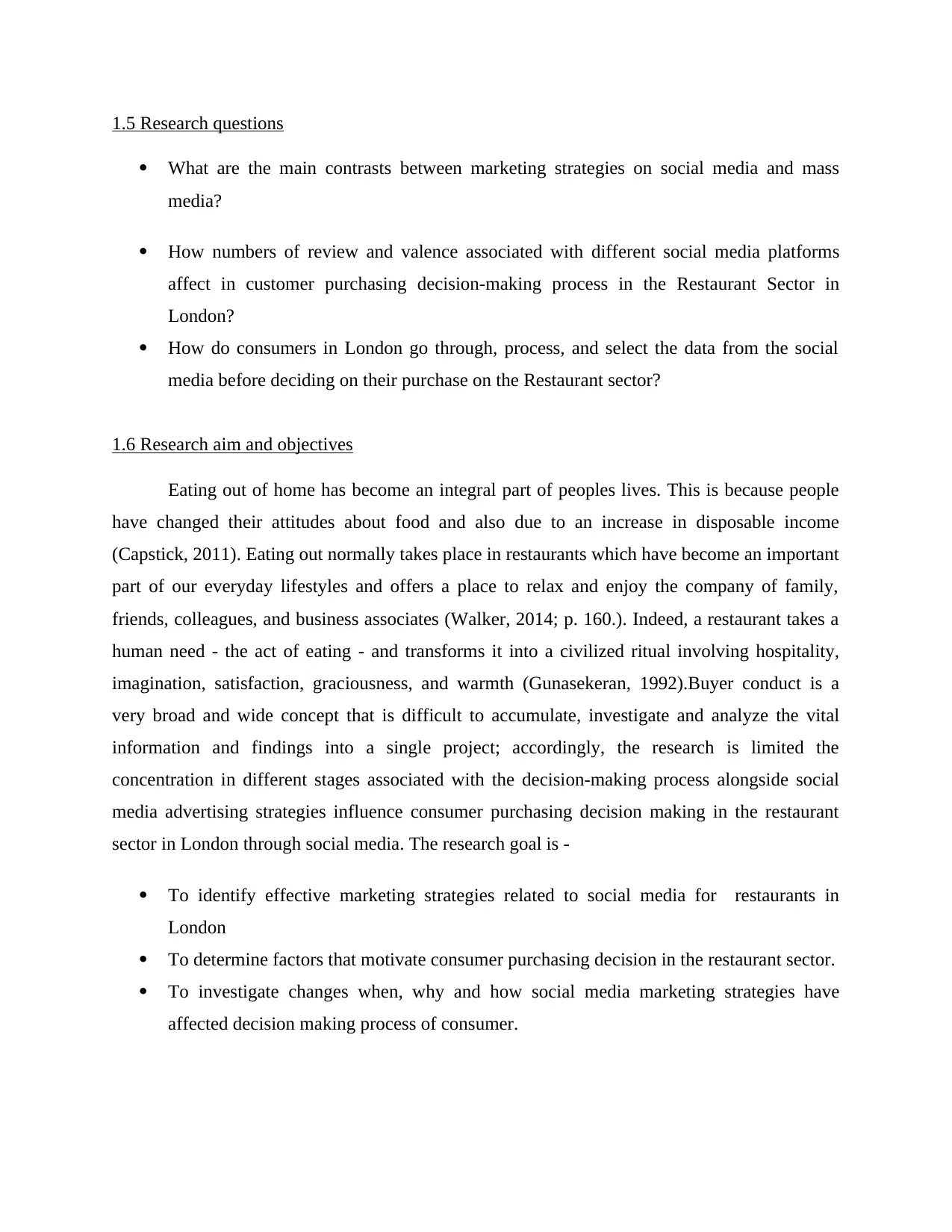
1.5 Research questions
What are the main contrasts between marketing strategies on social media and mass
media?
How numbers of review and valence associated with different social media platforms
affect in customer purchasing decision-making process in the Restaurant Sector in
London?
How do consumers in London go through, process, and select the data from the social
media before deciding on their purchase on the Restaurant sector?
1.6 Research aim and objectives
Eating out of home has become an integral part of peoples lives. This is because people
have changed their attitudes about food and also due to an increase in disposable income
(Capstick, 2011). Eating out normally takes place in restaurants which have become an important
part of our everyday lifestyles and offers a place to relax and enjoy the company of family,
friends, colleagues, and business associates (Walker, 2014; p. 160.). Indeed, a restaurant takes a
human need - the act of eating - and transforms it into a civilized ritual involving hospitality,
imagination, satisfaction, graciousness, and warmth (Gunasekeran, 1992).Buyer conduct is a
very broad and wide concept that is difficult to accumulate, investigate and analyze the vital
information and findings into a single project; accordingly, the research is limited the
concentration in different stages associated with the decision-making process alongside social
media advertising strategies influence consumer purchasing decision making in the restaurant
sector in London through social media. The research goal is -
To identify effective marketing strategies related to social media for restaurants in
London
To determine factors that motivate consumer purchasing decision in the restaurant sector.
To investigate changes when, why and how social media marketing strategies have
affected decision making process of consumer.
What are the main contrasts between marketing strategies on social media and mass
media?
How numbers of review and valence associated with different social media platforms
affect in customer purchasing decision-making process in the Restaurant Sector in
London?
How do consumers in London go through, process, and select the data from the social
media before deciding on their purchase on the Restaurant sector?
1.6 Research aim and objectives
Eating out of home has become an integral part of peoples lives. This is because people
have changed their attitudes about food and also due to an increase in disposable income
(Capstick, 2011). Eating out normally takes place in restaurants which have become an important
part of our everyday lifestyles and offers a place to relax and enjoy the company of family,
friends, colleagues, and business associates (Walker, 2014; p. 160.). Indeed, a restaurant takes a
human need - the act of eating - and transforms it into a civilized ritual involving hospitality,
imagination, satisfaction, graciousness, and warmth (Gunasekeran, 1992).Buyer conduct is a
very broad and wide concept that is difficult to accumulate, investigate and analyze the vital
information and findings into a single project; accordingly, the research is limited the
concentration in different stages associated with the decision-making process alongside social
media advertising strategies influence consumer purchasing decision making in the restaurant
sector in London through social media. The research goal is -
To identify effective marketing strategies related to social media for restaurants in
London
To determine factors that motivate consumer purchasing decision in the restaurant sector.
To investigate changes when, why and how social media marketing strategies have
affected decision making process of consumer.
Paraphrase This Document
Need a fresh take? Get an instant paraphrase of this document with our AI Paraphraser
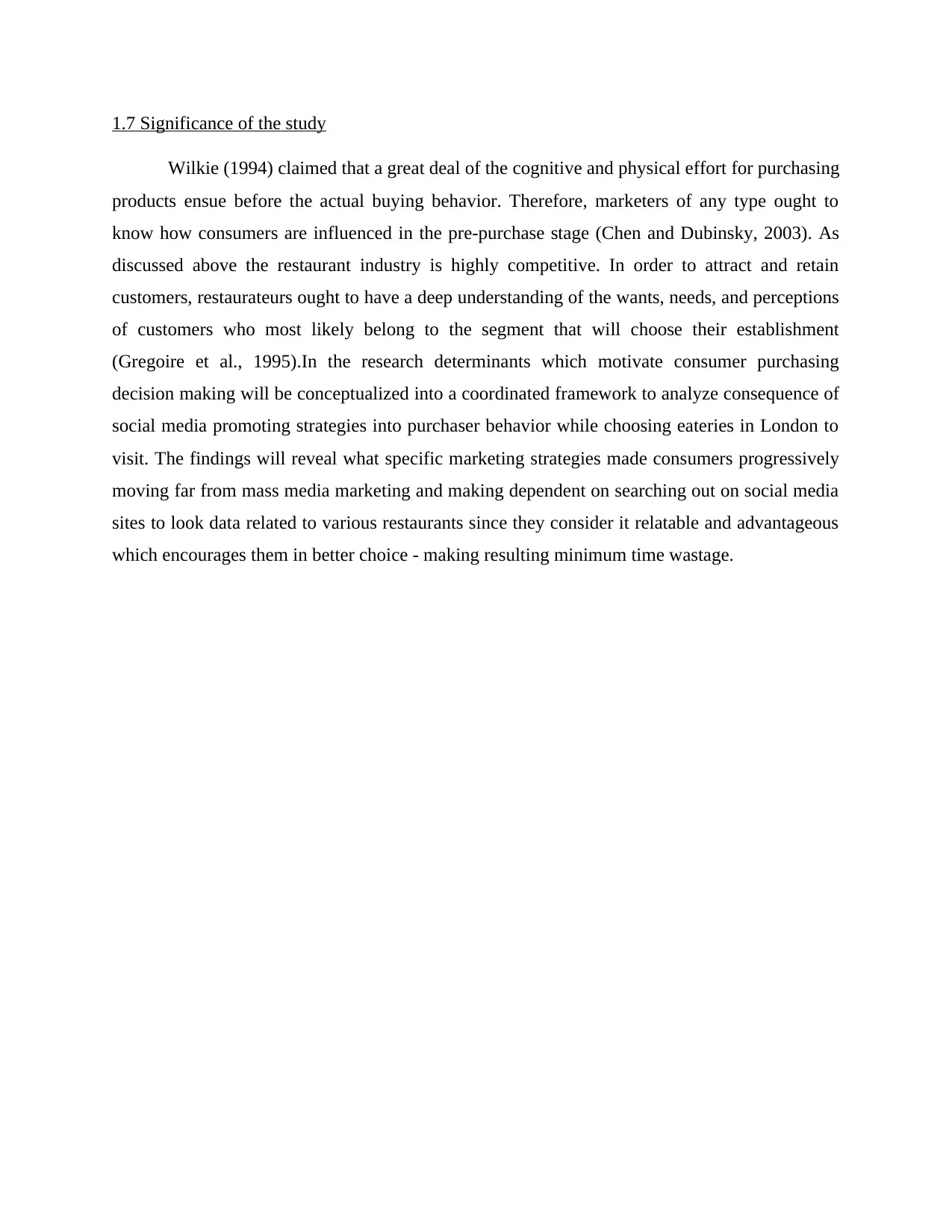
1.7 Significance of the study
Wilkie (1994) claimed that a great deal of the cognitive and physical effort for purchasing
products ensue before the actual buying behavior. Therefore, marketers of any type ought to
know how consumers are influenced in the pre-purchase stage (Chen and Dubinsky, 2003). As
discussed above the restaurant industry is highly competitive. In order to attract and retain
customers, restaurateurs ought to have a deep understanding of the wants, needs, and perceptions
of customers who most likely belong to the segment that will choose their establishment
(Gregoire et al., 1995).In the research determinants which motivate consumer purchasing
decision making will be conceptualized into a coordinated framework to analyze consequence of
social media promoting strategies into purchaser behavior while choosing eateries in London to
visit. The findings will reveal what specific marketing strategies made consumers progressively
moving far from mass media marketing and making dependent on searching out on social media
sites to look data related to various restaurants since they consider it relatable and advantageous
which encourages them in better choice - making resulting minimum time wastage.
Wilkie (1994) claimed that a great deal of the cognitive and physical effort for purchasing
products ensue before the actual buying behavior. Therefore, marketers of any type ought to
know how consumers are influenced in the pre-purchase stage (Chen and Dubinsky, 2003). As
discussed above the restaurant industry is highly competitive. In order to attract and retain
customers, restaurateurs ought to have a deep understanding of the wants, needs, and perceptions
of customers who most likely belong to the segment that will choose their establishment
(Gregoire et al., 1995).In the research determinants which motivate consumer purchasing
decision making will be conceptualized into a coordinated framework to analyze consequence of
social media promoting strategies into purchaser behavior while choosing eateries in London to
visit. The findings will reveal what specific marketing strategies made consumers progressively
moving far from mass media marketing and making dependent on searching out on social media
sites to look data related to various restaurants since they consider it relatable and advantageous
which encourages them in better choice - making resulting minimum time wastage.
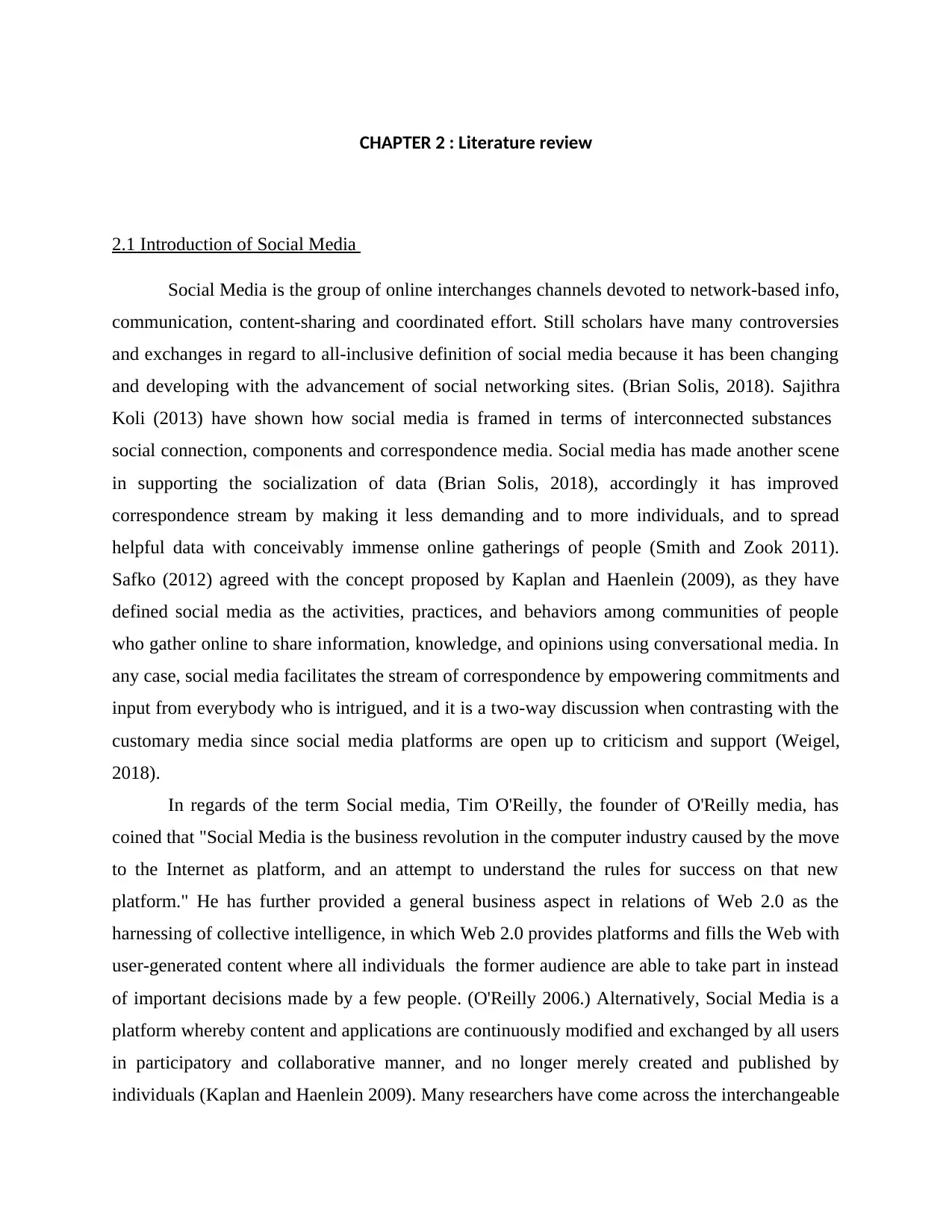
CHAPTER 2 : Literature review
2.1 Introduction of Social Media
Social Media is the group of online interchanges channels devoted to network-based info,
communication, content-sharing and coordinated effort. Still scholars have many controversies
and exchanges in regard to all-inclusive definition of social media because it has been changing
and developing with the advancement of social networking sites. (Brian Solis, 2018). Sajithra
Koli (2013) have shown how social media is framed in terms of interconnected substances
social connection, components and correspondence media. Social media has made another scene
in supporting the socialization of data (Brian Solis, 2018), accordingly it has improved
correspondence stream by making it less demanding and to more individuals, and to spread
helpful data with conceivably immense online gatherings of people (Smith and Zook 2011).
Safko (2012) agreed with the concept proposed by Kaplan and Haenlein (2009), as they have
defined social media as the activities, practices, and behaviors among communities of people
who gather online to share information, knowledge, and opinions using conversational media. In
any case, social media facilitates the stream of correspondence by empowering commitments and
input from everybody who is intrigued, and it is a two-way discussion when contrasting with the
customary media since social media platforms are open up to criticism and support (Weigel,
2018).
In regards of the term Social media, Tim O'Reilly, the founder of O'Reilly media, has
coined that "Social Media is the business revolution in the computer industry caused by the move
to the Internet as platform, and an attempt to understand the rules for success on that new
platform." He has further provided a general business aspect in relations of Web 2.0 as the
harnessing of collective intelligence, in which Web 2.0 provides platforms and fills the Web with
user-generated content where all individuals the former audience are able to take part in instead
of important decisions made by a few people. (O'Reilly 2006.) Alternatively, Social Media is a
platform whereby content and applications are continuously modified and exchanged by all users
in participatory and collaborative manner, and no longer merely created and published by
individuals (Kaplan and Haenlein 2009). Many researchers have come across the interchangeable
2.1 Introduction of Social Media
Social Media is the group of online interchanges channels devoted to network-based info,
communication, content-sharing and coordinated effort. Still scholars have many controversies
and exchanges in regard to all-inclusive definition of social media because it has been changing
and developing with the advancement of social networking sites. (Brian Solis, 2018). Sajithra
Koli (2013) have shown how social media is framed in terms of interconnected substances
social connection, components and correspondence media. Social media has made another scene
in supporting the socialization of data (Brian Solis, 2018), accordingly it has improved
correspondence stream by making it less demanding and to more individuals, and to spread
helpful data with conceivably immense online gatherings of people (Smith and Zook 2011).
Safko (2012) agreed with the concept proposed by Kaplan and Haenlein (2009), as they have
defined social media as the activities, practices, and behaviors among communities of people
who gather online to share information, knowledge, and opinions using conversational media. In
any case, social media facilitates the stream of correspondence by empowering commitments and
input from everybody who is intrigued, and it is a two-way discussion when contrasting with the
customary media since social media platforms are open up to criticism and support (Weigel,
2018).
In regards of the term Social media, Tim O'Reilly, the founder of O'Reilly media, has
coined that "Social Media is the business revolution in the computer industry caused by the move
to the Internet as platform, and an attempt to understand the rules for success on that new
platform." He has further provided a general business aspect in relations of Web 2.0 as the
harnessing of collective intelligence, in which Web 2.0 provides platforms and fills the Web with
user-generated content where all individuals the former audience are able to take part in instead
of important decisions made by a few people. (O'Reilly 2006.) Alternatively, Social Media is a
platform whereby content and applications are continuously modified and exchanged by all users
in participatory and collaborative manner, and no longer merely created and published by
individuals (Kaplan and Haenlein 2009). Many researchers have come across the interchangeable
⊘ This is a preview!⊘
Do you want full access?
Subscribe today to unlock all pages.

Trusted by 1+ million students worldwide
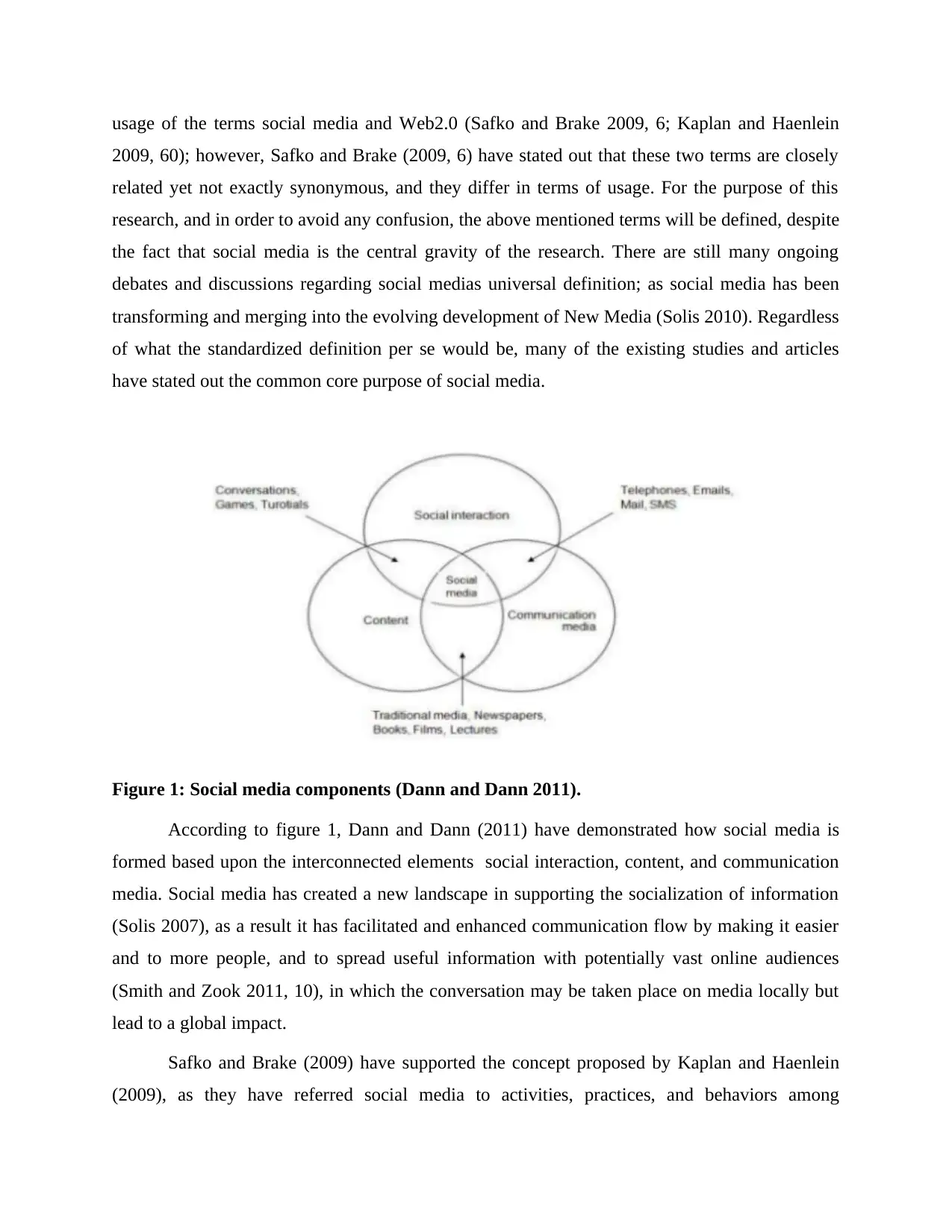
usage of the terms social media and Web2.0 (Safko and Brake 2009, 6; Kaplan and Haenlein
2009, 60); however, Safko and Brake (2009, 6) have stated out that these two terms are closely
related yet not exactly synonymous, and they differ in terms of usage. For the purpose of this
research, and in order to avoid any confusion, the above mentioned terms will be defined, despite
the fact that social media is the central gravity of the research. There are still many ongoing
debates and discussions regarding social medias universal definition; as social media has been
transforming and merging into the evolving development of New Media (Solis 2010). Regardless
of what the standardized definition per se would be, many of the existing studies and articles
have stated out the common core purpose of social media.
Figure 1: Social media components (Dann and Dann 2011).
According to figure 1, Dann and Dann (2011) have demonstrated how social media is
formed based upon the interconnected elements social interaction, content, and communication
media. Social media has created a new landscape in supporting the socialization of information
(Solis 2007), as a result it has facilitated and enhanced communication flow by making it easier
and to more people, and to spread useful information with potentially vast online audiences
(Smith and Zook 2011, 10), in which the conversation may be taken place on media locally but
lead to a global impact.
Safko and Brake (2009) have supported the concept proposed by Kaplan and Haenlein
(2009), as they have referred social media to activities, practices, and behaviors among
2009, 60); however, Safko and Brake (2009, 6) have stated out that these two terms are closely
related yet not exactly synonymous, and they differ in terms of usage. For the purpose of this
research, and in order to avoid any confusion, the above mentioned terms will be defined, despite
the fact that social media is the central gravity of the research. There are still many ongoing
debates and discussions regarding social medias universal definition; as social media has been
transforming and merging into the evolving development of New Media (Solis 2010). Regardless
of what the standardized definition per se would be, many of the existing studies and articles
have stated out the common core purpose of social media.
Figure 1: Social media components (Dann and Dann 2011).
According to figure 1, Dann and Dann (2011) have demonstrated how social media is
formed based upon the interconnected elements social interaction, content, and communication
media. Social media has created a new landscape in supporting the socialization of information
(Solis 2007), as a result it has facilitated and enhanced communication flow by making it easier
and to more people, and to spread useful information with potentially vast online audiences
(Smith and Zook 2011, 10), in which the conversation may be taken place on media locally but
lead to a global impact.
Safko and Brake (2009) have supported the concept proposed by Kaplan and Haenlein
(2009), as they have referred social media to activities, practices, and behaviors among
Paraphrase This Document
Need a fresh take? Get an instant paraphrase of this document with our AI Paraphraser
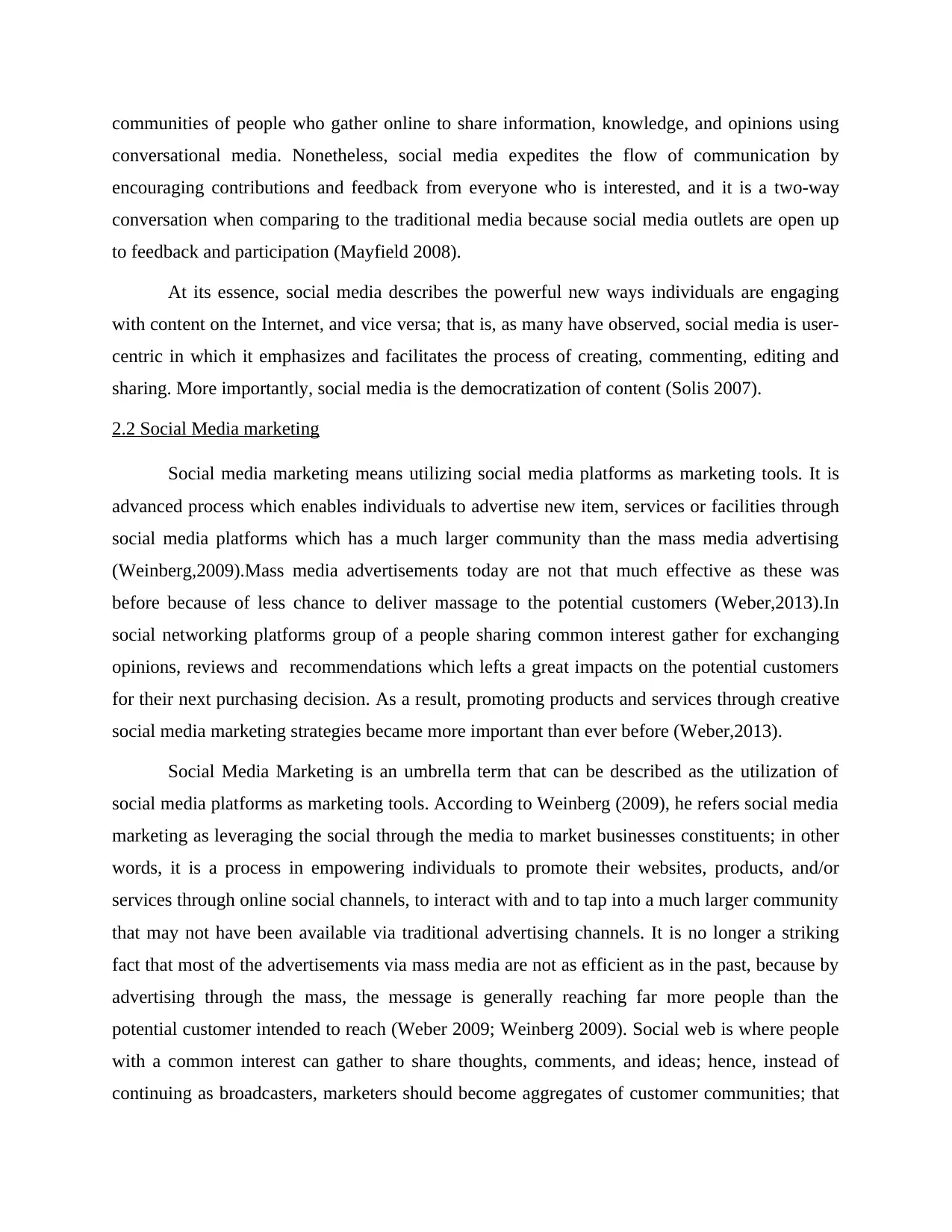
communities of people who gather online to share information, knowledge, and opinions using
conversational media. Nonetheless, social media expedites the flow of communication by
encouraging contributions and feedback from everyone who is interested, and it is a two-way
conversation when comparing to the traditional media because social media outlets are open up
to feedback and participation (Mayfield 2008).
At its essence, social media describes the powerful new ways individuals are engaging
with content on the Internet, and vice versa; that is, as many have observed, social media is user-
centric in which it emphasizes and facilitates the process of creating, commenting, editing and
sharing. More importantly, social media is the democratization of content (Solis 2007).
2.2 Social Media marketing
Social media marketing means utilizing social media platforms as marketing tools. It is
advanced process which enables individuals to advertise new item, services or facilities through
social media platforms which has a much larger community than the mass media advertising
(Weinberg,2009).Mass media advertisements today are not that much effective as these was
before because of less chance to deliver massage to the potential customers (Weber,2013).In
social networking platforms group of a people sharing common interest gather for exchanging
opinions, reviews and recommendations which lefts a great impacts on the potential customers
for their next purchasing decision. As a result, promoting products and services through creative
social media marketing strategies became more important than ever before (Weber,2013).
Social Media Marketing is an umbrella term that can be described as the utilization of
social media platforms as marketing tools. According to Weinberg (2009), he refers social media
marketing as leveraging the social through the media to market businesses constituents; in other
words, it is a process in empowering individuals to promote their websites, products, and/or
services through online social channels, to interact with and to tap into a much larger community
that may not have been available via traditional advertising channels. It is no longer a striking
fact that most of the advertisements via mass media are not as efficient as in the past, because by
advertising through the mass, the message is generally reaching far more people than the
potential customer intended to reach (Weber 2009; Weinberg 2009). Social web is where people
with a common interest can gather to share thoughts, comments, and ideas; hence, instead of
continuing as broadcasters, marketers should become aggregates of customer communities; that
conversational media. Nonetheless, social media expedites the flow of communication by
encouraging contributions and feedback from everyone who is interested, and it is a two-way
conversation when comparing to the traditional media because social media outlets are open up
to feedback and participation (Mayfield 2008).
At its essence, social media describes the powerful new ways individuals are engaging
with content on the Internet, and vice versa; that is, as many have observed, social media is user-
centric in which it emphasizes and facilitates the process of creating, commenting, editing and
sharing. More importantly, social media is the democratization of content (Solis 2007).
2.2 Social Media marketing
Social media marketing means utilizing social media platforms as marketing tools. It is
advanced process which enables individuals to advertise new item, services or facilities through
social media platforms which has a much larger community than the mass media advertising
(Weinberg,2009).Mass media advertisements today are not that much effective as these was
before because of less chance to deliver massage to the potential customers (Weber,2013).In
social networking platforms group of a people sharing common interest gather for exchanging
opinions, reviews and recommendations which lefts a great impacts on the potential customers
for their next purchasing decision. As a result, promoting products and services through creative
social media marketing strategies became more important than ever before (Weber,2013).
Social Media Marketing is an umbrella term that can be described as the utilization of
social media platforms as marketing tools. According to Weinberg (2009), he refers social media
marketing as leveraging the social through the media to market businesses constituents; in other
words, it is a process in empowering individuals to promote their websites, products, and/or
services through online social channels, to interact with and to tap into a much larger community
that may not have been available via traditional advertising channels. It is no longer a striking
fact that most of the advertisements via mass media are not as efficient as in the past, because by
advertising through the mass, the message is generally reaching far more people than the
potential customer intended to reach (Weber 2009; Weinberg 2009). Social web is where people
with a common interest can gather to share thoughts, comments, and ideas; hence, instead of
continuing as broadcasters, marketers should become aggregates of customer communities; that
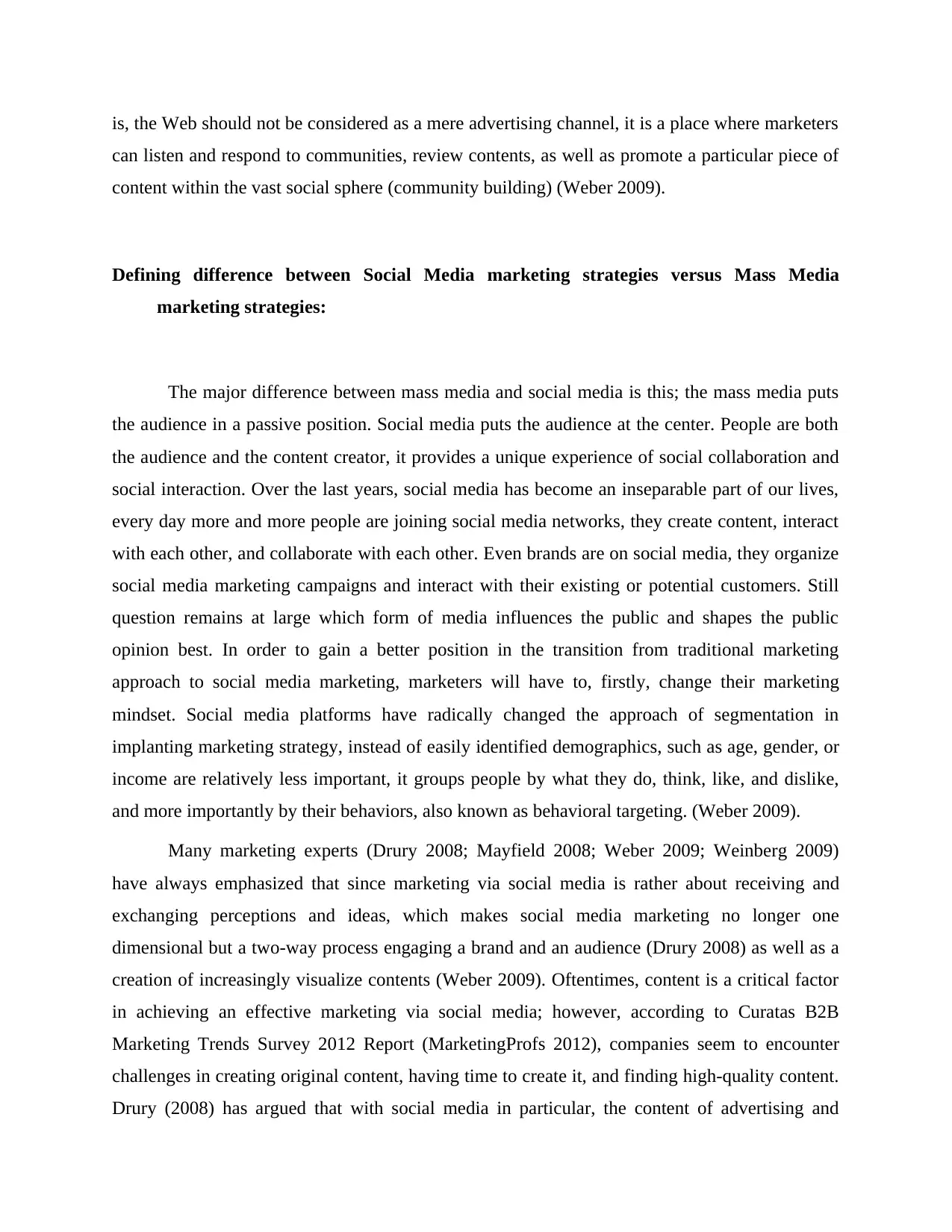
is, the Web should not be considered as a mere advertising channel, it is a place where marketers
can listen and respond to communities, review contents, as well as promote a particular piece of
content within the vast social sphere (community building) (Weber 2009).
Defining difference between Social Media marketing strategies versus Mass Media
marketing strategies:
The major difference between mass media and social media is this; the mass media puts
the audience in a passive position. Social media puts the audience at the center. People are both
the audience and the content creator, it provides a unique experience of social collaboration and
social interaction. Over the last years, social media has become an inseparable part of our lives,
every day more and more people are joining social media networks, they create content, interact
with each other, and collaborate with each other. Even brands are on social media, they organize
social media marketing campaigns and interact with their existing or potential customers. Still
question remains at large which form of media influences the public and shapes the public
opinion best. In order to gain a better position in the transition from traditional marketing
approach to social media marketing, marketers will have to, firstly, change their marketing
mindset. Social media platforms have radically changed the approach of segmentation in
implanting marketing strategy, instead of easily identified demographics, such as age, gender, or
income are relatively less important, it groups people by what they do, think, like, and dislike,
and more importantly by their behaviors, also known as behavioral targeting. (Weber 2009).
Many marketing experts (Drury 2008; Mayfield 2008; Weber 2009; Weinberg 2009)
have always emphasized that since marketing via social media is rather about receiving and
exchanging perceptions and ideas, which makes social media marketing no longer one
dimensional but a two-way process engaging a brand and an audience (Drury 2008) as well as a
creation of increasingly visualize contents (Weber 2009). Oftentimes, content is a critical factor
in achieving an effective marketing via social media; however, according to Curatas B2B
Marketing Trends Survey 2012 Report (MarketingProfs 2012), companies seem to encounter
challenges in creating original content, having time to create it, and finding high-quality content.
Drury (2008) has argued that with social media in particular, the content of advertising and
can listen and respond to communities, review contents, as well as promote a particular piece of
content within the vast social sphere (community building) (Weber 2009).
Defining difference between Social Media marketing strategies versus Mass Media
marketing strategies:
The major difference between mass media and social media is this; the mass media puts
the audience in a passive position. Social media puts the audience at the center. People are both
the audience and the content creator, it provides a unique experience of social collaboration and
social interaction. Over the last years, social media has become an inseparable part of our lives,
every day more and more people are joining social media networks, they create content, interact
with each other, and collaborate with each other. Even brands are on social media, they organize
social media marketing campaigns and interact with their existing or potential customers. Still
question remains at large which form of media influences the public and shapes the public
opinion best. In order to gain a better position in the transition from traditional marketing
approach to social media marketing, marketers will have to, firstly, change their marketing
mindset. Social media platforms have radically changed the approach of segmentation in
implanting marketing strategy, instead of easily identified demographics, such as age, gender, or
income are relatively less important, it groups people by what they do, think, like, and dislike,
and more importantly by their behaviors, also known as behavioral targeting. (Weber 2009).
Many marketing experts (Drury 2008; Mayfield 2008; Weber 2009; Weinberg 2009)
have always emphasized that since marketing via social media is rather about receiving and
exchanging perceptions and ideas, which makes social media marketing no longer one
dimensional but a two-way process engaging a brand and an audience (Drury 2008) as well as a
creation of increasingly visualize contents (Weber 2009). Oftentimes, content is a critical factor
in achieving an effective marketing via social media; however, according to Curatas B2B
Marketing Trends Survey 2012 Report (MarketingProfs 2012), companies seem to encounter
challenges in creating original content, having time to create it, and finding high-quality content.
Drury (2008) has argued that with social media in particular, the content of advertising and
⊘ This is a preview!⊘
Do you want full access?
Subscribe today to unlock all pages.

Trusted by 1+ million students worldwide
1 out of 49
Related Documents
Your All-in-One AI-Powered Toolkit for Academic Success.
+13062052269
info@desklib.com
Available 24*7 on WhatsApp / Email
![[object Object]](/_next/static/media/star-bottom.7253800d.svg)
Unlock your academic potential
Copyright © 2020–2025 A2Z Services. All Rights Reserved. Developed and managed by ZUCOL.




